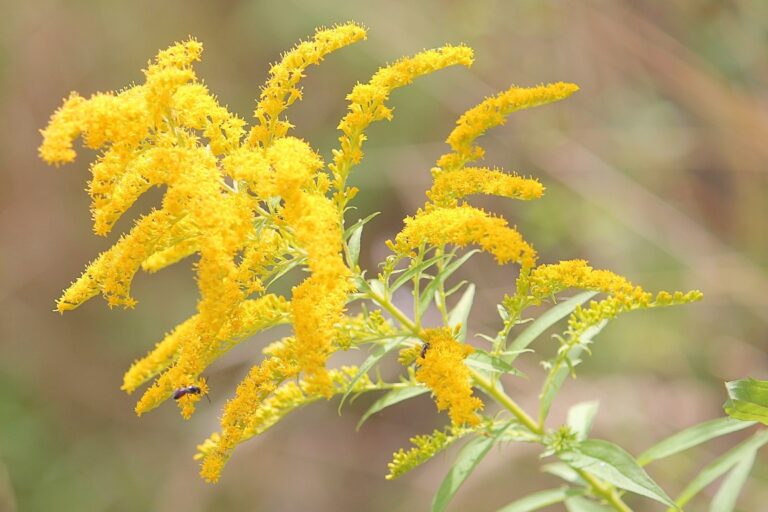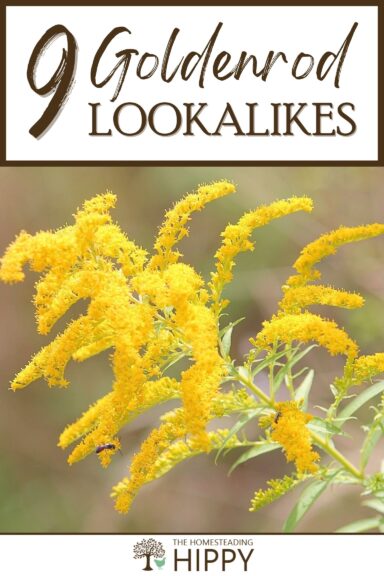Goldenrod is an important plant with many different uses, from food to making dye, and perhaps best known for lending its name and tone to the famous Crayola crayons.

But Goldenrod is also commonly mistaken for ragweed, among many other plants. Some of them can be quite dangerous!
Whatever reason you are forging for Goldenrod, it is imperative you positively identify the plant. If you make a mistake you might be wasting your time or potentially putting your own life in danger.
Keep reading, and I’ll tell you about nine of the most important Goldenrod lookalikes you should learn how to recognize.
A Note on Goldenrod Species
One thing to note about Goldenrod is that it isn’t a single plant we are talking about. Yes, the majority have a broadly similar shape and similar, cheery yellow flowers, but not all!
In fact, many species of Goldenrod form a group of plants that is so diverse some of them don’t even look like Goldenrod in the slightest!
Some might have white flowers, or a pale flower that only develops that vivid color after blooming.
In fact, this is such a perplexing problem that entire groups exist online to helping people positively identify goldenrod species that might be growing in their area, and even then the analysis is often anything but certain!
Accordingly, I urge you to get expert training and familiarization with any and all goldenrod species along with its look-alikes that might be growing in your area.
It’s easy to make a mistake when identifying any wild plants, but rarely is it easier than when working with goldenrod.
1. Groundsel (Senecio vulgaris)
When you’re out in the wild, it’s easy to mistake Groundsel for Goldenrod: Both plants share a striking resemblance with their stacks of bright yellow flowers, and Groundsel is further typically found in gardens and fields across much of North America and Europe, making it a common sight.
The plant blooms throughout the year with its clusters of small daisy-like flowers, and that might be the best way to ID it; it can bloom when Goldenrod won’t.
But, unlike Goldenrod, Groundsel is definitely a toxic plant. Its leaves contain alkaloid toxins which can cause liver damage if ingested by mammals. This is one lookalike you cannot afford to make a mistake with!
2. Ragwort (Jacobaea vulgaris)
You might mistake Ragwort for Goldenrod since it grows similarly to Goldenrod and in much of the same places, sprouting in meadows, pastures, and along the roadsides.
Likewise, the delicate, bright yellow flowers of this plant could easily fool you into thinking you’ve stumbled upon a patch of Goldenrod. That’s where you could go very wrong!
Look closer, though, and you’ll see that Ragwort’s flowers are more ragged and significantly less dense than Goldenrod’s.
And also like Groundsel, above, Ragwort is dangerous due to its high concentrations of similar alkaloids toxins, which are poisonous to humans and livestock alike if eaten.
Luckily, it tastes horrid, so people, at least, are not likely to eat it…
3. Ragweed (Ambrosia artemisiifolia)
Ragweed might not have the same yellow flowers of Goldenrod, but its tall stalks and feathery, greenish blooms can cause you to confuse it at a glance, especially when the blooms are developing or young.
This plant is also commonly found all over in disturbed soils, fields and on roadsides throughout North America, increasing the instances of mistaken identity.
And, luckily, while Ragweed is not toxic like Groundsel or Ragwort up there, it poses its own insidious threat: seasonal allergies! A bit dramatic, yes, but Ragweed pollen is a major causes of intense seasonal allergies.
So, while you won’t need to worry about touching it, you still want to give this plant a wide berth during its blooming period in late summer and fall if you suffer from pollen allergies even a little!
4. Tansy (Tanacetum vulgare)
Tansy is native to Europe and Asia but can now be found throughout North America and other nations where it has become naturalized and increasingly invasive.
You might come across Tansy anywhere you’d find Goldenrod, which leads to it being mistaken for Goldenrod all the time!
Both plants share bright yellow blooms, but Tansy has button-like, flat-topped clusters of flowers compared to Goldenrod’s “stacks” or plume-like clusters.
And beware! Tansy’s leaves and flowers contain various toxic compounds that can cause serious harm if ingested or even if handled excessively, among them thujone, which can cause convulsions and brain damage.
5. St. John’s Wort (Hypericum perforatum)
An herbal medicine employed by indigenous tribes everywhere it was found, St. John’s Wort is a helpful, safe plant but one that you might mistake for Goldenrod.
Both plants have bright yellow flowers, but color and size are where the similarities end: unlike Goldenrod’s dense clusters of tiny flowers, St. John’s Wort has larger, individual, star-shaped flowers that are showier.
Still, it could be confused at a distance or by the uninitiated. Look out for it in meadows and along the edges of dense forests.
6. Rabbitbrush (Chrysothamnus nauseosus)
Rabbitbrush gets its name from its tall, bushy form-factor, and it shares bright yellow, late-season flowers with Goldenrod, a fact which can easily lead you to mix them up.
But you will only find Rabbitbrush in some specific biomes: It thrives in dry and sandy soils, and is only commonly found in the western regions of North America.
Unlike some of the other imposters on our list, Rabbitbrush is neither dangerous nor helpful. It’s simply a hardy plant that adds a little color to dry and sometimes dusty places.
But as always, those with sensitive skin or known plant allergies may experience irritation from handling the plant. Otherwise, so long as you don’t mix them up, it won’t cause any real harm.
7. Yellow Loosestrife (Lysimachia vulgaris)
Yellow Loosestrife is a wildflower with a vaguely ominous name, and it’s a plant that prefers a more aquatic environment than Goldenrod, often being found growing near water.
Another plant with summery, five-petaled, small yellow blooms (ones with orange centers), the growth habit, stems and foliage are otherwise very different.
Nonetheless, you might mix it up for Goldenrod if its preferred habitat happens to border one where Goldenrod is common.
It is pretty, but also an invasive species currently out-of-control in many places; imported far and wide from its home in Central Europe, it has since run amok from gardens and beds.
8. Stickweed (Galinsoga quadriradiata)
Stickweed, sometimes known colloquially as Galinsoga, is yet another plant that you might confuse for Goldenrod.
Again, we see small, bright yellow flowers, though these are three-pointed and bigger than Goldenrod’s.
However, Stickweed is usually much shorter than Goldenrod, has arrow-straight stems (hence the name) and prefers much-disturbed habitats like gardens and roadsides to any other location.
It’s not a dangerous lookalike, but one gardeners likely won’t appreciate since it is aggressively competitive and invasive…
9. Wingstem (Verbesina alternifolia)
Tall, robust and topped with clusters of yellow flowers, Wingstem (aka yellow ironweed) certainly shares some upfront similarities with Goldenrod.
It also grows commonly in woodlands and moist, low-lying areas, sometimes directly along stream banks, so you might come across it on any nature walk.
Close inspection will reveal that Wingstem’s flowers are larger, with drooping sunflower-like petals, easily setting it apart from the dense growth habit and tiny clusters of equally tiny flowers on Goldenrod.
Wingstem is another innocuous imposter, not dangerous or beneficial. It’s just another interesting part of our landscape, though it is an important food source for long-tongued insects, including butterflies and some bees.

Tim is a farm boy with vast experience on homesteads, and with survival and prepping. He lives a self-reliant lifestyle along with his aging mother in a quiet and very conservative little town in Ohio. He teaches folks about security, prepping and self-sufficiency not just through his witty writing, but also in person.
Find out more about Tim and the rest of the crew here.
